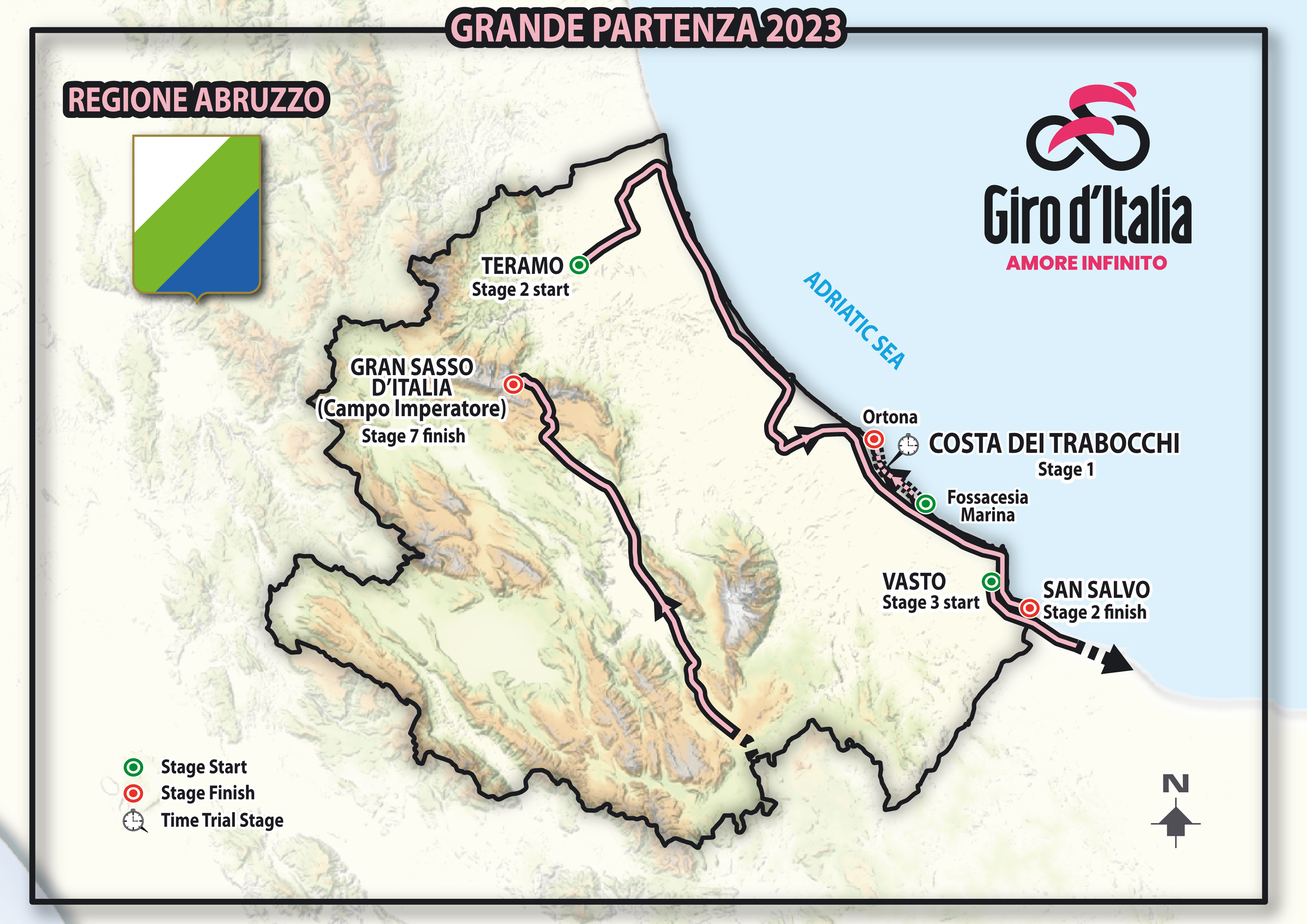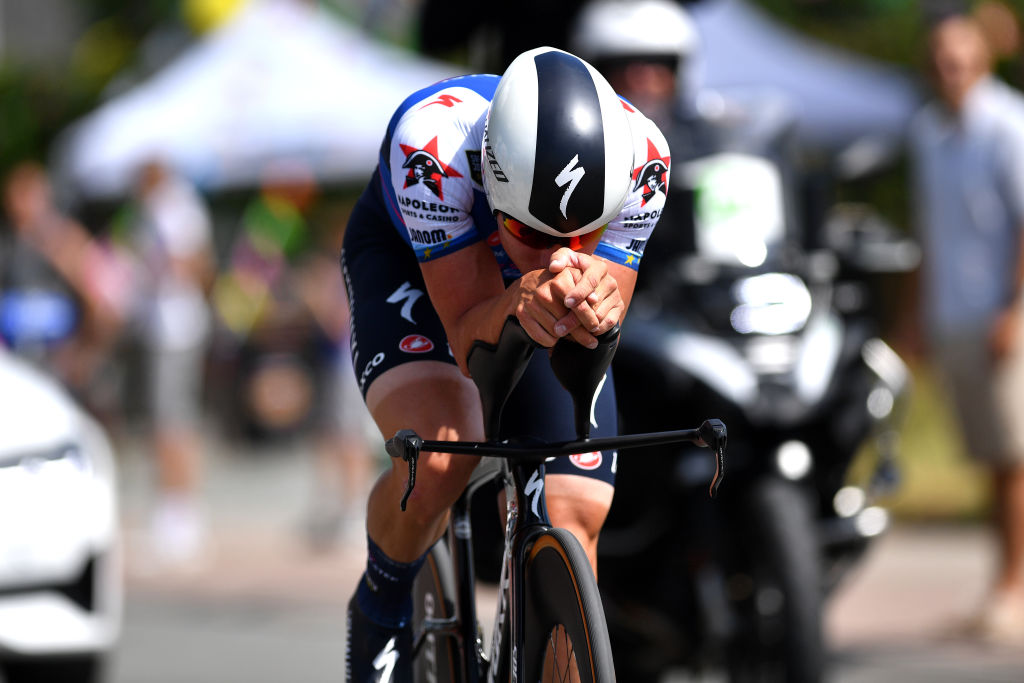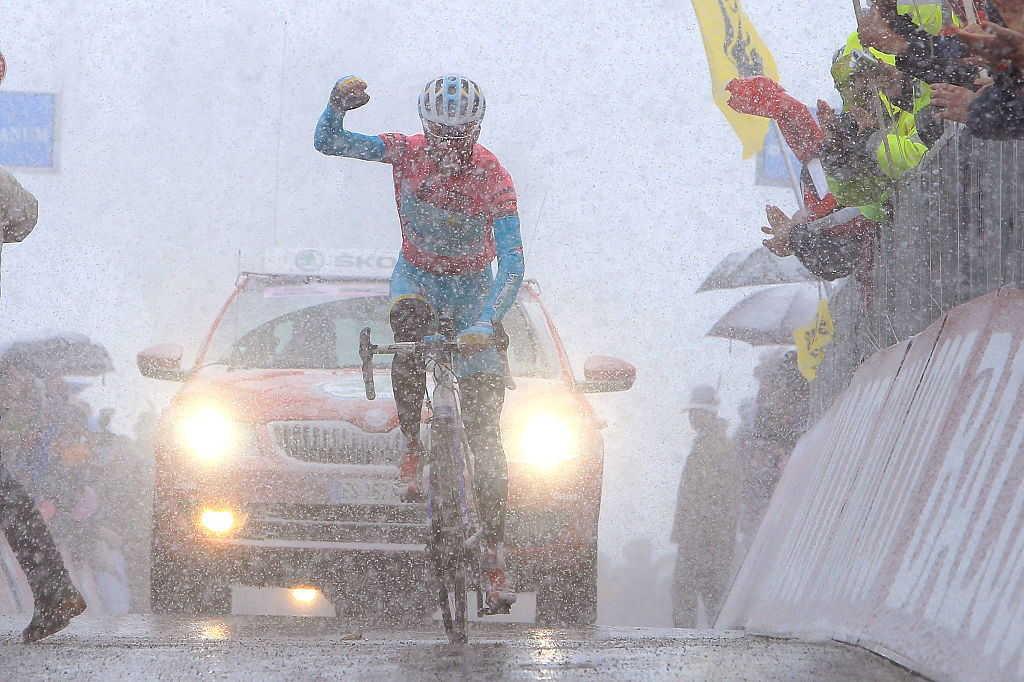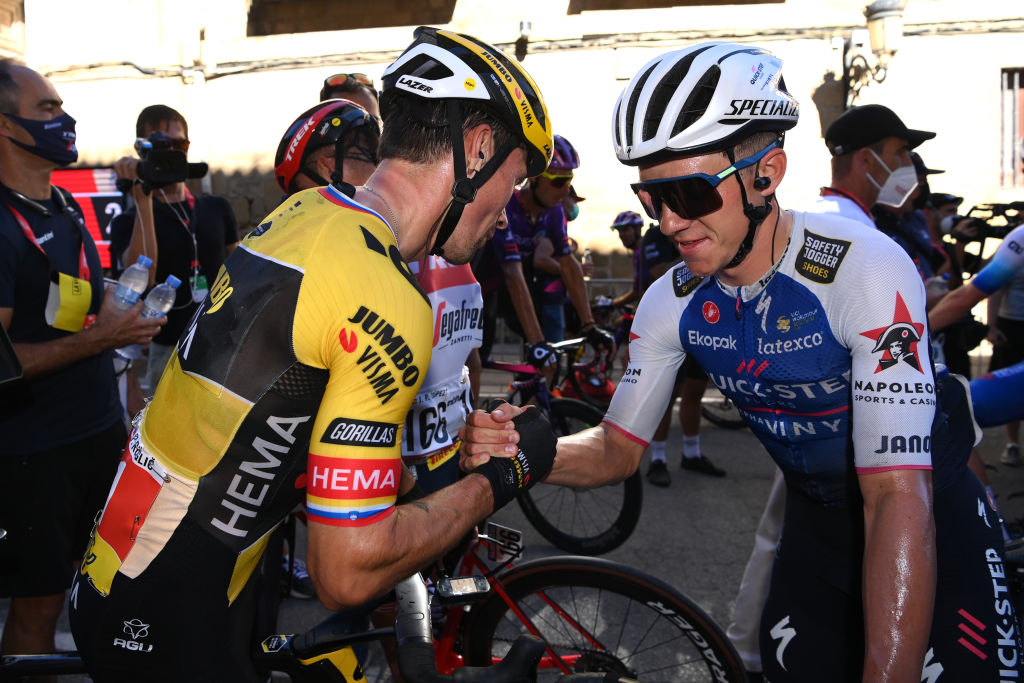2023 Giro d'Italia route set to include three time trials to tempt Evenepoel away from Tour de France
All the rumours ahead of the official unveiling on October 17

When the curtain goes up on the full 2023 Giro d’Italia route in Milan on Monday October 17, there appears to be every chance that Remco Evenepoel will like what he sees.
Giro d’Italia race director Mauro Vegni has made no secret of his desire to bring the new world champion back to his race next year and the early indications are that the 2023 route will feature three individual time trials to tempt Evenepoel to ride the Corsa Rosa in the rainbow jersey.
The first of those time trials was confirmed on Wednesday morning, when RCS Sport formally unveiled the Grande Partenza of the 2023 Giro in Abruzzo.
The opening stage is an 18.4km individual time trial from Fossacesia to Ortona in the hinterland of Pescara. A day later, the sprinters will have an opportunity at the end of the 204km run from Teramo to San Salvo, while RCS Sport has also announced that the Giro will return to the Abruzzo region on stage 7 for a summit finish at Gran Sasso d’Italia, the first time the race climbs above 2,000 metres.
Speaking on Wednesday morning in Pescara, Vegni pointed out that the race would not scale such heights too often thereafter. Instead, in keeping with longstanding rumours of a time trial-laden course, he suggested that the 2023 Giro would be less mountainous and less demanding than this year’s race, where Jai Hindley emerged victorious ahead of Richard Carapaz.
"We have deliberately chosen a less complicated and technical route than last year, and we won’t have stages that go above 2,500 metres in altitude," Vegni told Tuttobici.
"My dream would be to see a lot of important names at our race because we have one of the most beautiful races in the world, and the riders themselves say so."
Get The Leadout Newsletter
The latest race content, interviews, features, reviews and expert buying guides, direct to your inbox!
The initial rationale for the less onerous route was undoubtedly RCS Sport’s efforts to tempt Tadej Pogačar into trying the Giro-Tour double, but Vegni has all but accepted that the Slovenian’s Corsa Rosa debut will have to wait for another year.
After losing his Tour de France crown to Jonas Vingegaard last July, it seems most likely that Pogačar will make winning it back again the centrepiece of his 2023 season.
"I would have liked to have seen Pogačar at the Giro next year, but he’ll definitely do the Tour," Vegni admitted.
"However, I wouldn’t rule out the participation of Primož Roglič or Remco Evenepoel. We don’t have news about them yet, but it will certainly be a race for them."
The finer details of the route will only sharpen into focus on October 17, but already some of the broader brushstrokes of the 2023 Giro are visible thanks to local media reports.
Southern Italian Grande Partenza

Nebulous rumours of a Pescara start had long since solidified into fact before Wednesday’s Grande Partenza announcement, but confirmation that the nearby Gran Sasso d’Italia features just five days later places a clear limit on how far south the Giro will venture in 2023. A return to Sicily – which has appeared in four of the past six editions – can already be ruled out.
Vasto looks likely to host the start of stage 3, and it seems certain that the Giro will make a foray into Campania, perhaps that same day. Lago Laceno, a medium mountain summit finish in 1998 and 2012, has been touted as a possible stage finish, though local news outlets have been quiet on the idea in recent weeks.
RAI’s Campania studio has reported that Sorrento is set to host a stage finish in homage to former Giro organiser Carmine Castellano, who was born in the coastal town. Caserta is also understood to have made overtures to hold a stage finish to commemorate the 250th anniversary of the death of architect Luigi Vanvitelli, with a finale in front of the Bourbon palace he designed.
By stage 7, the race will again be heading northwards for the confirmed summit finish at Gran Sasso, where Simon Yates claimed victory in 2018 and Marco Pantani triumphed in 1999.
On the second weekend of the Giro, the direction of travel will be northwards, with at least one stage taking place in Umbria. Il Corriere dell’Umbria reports that Terni will host either a start or finish, while Il Resto del Carlino has confirmed that Fossombrone in the Marche has also bid to host a finish.
Time trial options

The second week of the Giro looks like something of a blank canvas at this juncture but RCS Sport has everything planned, with the full route presentation set for October 17.
Another flat time trial, this time of around 30km, appears certain to feature, but it’s not entirely clear where. One hypothesis floated by Tuttobici would see the time trial slotted into the route when the Giro visits Emilia-Romagna. In any case, the Giro will pass through the region early in week two, with local media reporting Cesena as the site for a possible stage start. Viadana in Lombardy has also publicly courted the Giro for a stage finish.
The other possible – and perhaps more likely – site for the second time trial is in Piedmont. La Gazzetta dello Sport already confirmed in March that the 2023 Giro would visit Fausto Coppi’s birthplace of Castellania to mark the 70th anniversary of his fifth and final overall win. The newspaper suggested then that the village might host the finish of a time trial that sets out from amid the vineyards of Gavi – in other words, the 2023 Giro’s 'wine stage'.
Elsewhere in Piedmont, Acqui Terme has made no secret of its candidature to host the Giro, and BiciSport now reports that the town will be the site of the finish of a "very interesting" stage in the second week.
At this juncture, it appears that Tuscany will be bypassed, despite reports earlier this year that the ski resort of Abetone was keen to host a stage of the 2023 Giro. With the 2024 Tour de France heavily rumoured to be starting in Florence, however, it may be that the region’s budget for Grand Tour cycling is tied up elsewhere for the time being.
Swiss broadcaster RTS has reported that the Giro will cross into Switzerland towards the end of the second week – perhaps on stage 13 – for a mountain stage with a summit finish at Crans Montana, where Laurent Fignon won in the yellow jersey on the 1984 Tour de France.
After crossing back into Italy on stage 14 – with a rumoured finish at Cesano – the Giro would then bring the curtain down on week two with a demanding stage in the hinterland of Bergamo to tie in with the city’s status as Italy’s joint capital of culture for 2023.
Il Corriere Bergamo reports that stage 15 could be something of a miniature Tour of Lombardy, with the ascents of Roncola, Berbenno, Dossena, Zambla Alta and Ganda all crammed into just 150km.
Tre Cime di Lavaredo and a mountain TT before Rome finale

As always, the final week of the Giro will be crammed with its most demanding mountain stages and, in keeping with tradition, details of several have already filtered into the pages of the local press across the peninsula.
Multiple outlets have reported that the Giro will resume after its final rest day with a summit finish at Monte Bondone overlooking Trento. The mountain, synonymous with Charly Gaul’s snowbound impresa in 1956, last featured on the route in 2006. This time out, it would come on stage 16, which is expected to start just north of Brescia in Sabbio Chiese.
The consensus from local newspapers in northern Italy is that the following day’s stage will head to the Veneto coast for a finish in Caorle that would offer the sprinters their final opportunity of the race. The climbing resumes on stage 18, which La Tribuna di Treviso reports will conclude in the southern Dolomites on the 10km-long Passo Cibiana. There are also suggestions, mind, that the Cibiana could serve as the penultimate ascent before a finish at nearby Rifugio Palafavera.
According to Il Messaggero Veneto, the Giro will pay homage to the victims of the 1963 Vajont dam disaster by holding the start of stage 19 in Longarone ahead of a summit finish on the Tre Cime di Lavaredo. That storied climb was last included in 2013, when Vincenzo Nibali won in the snow to cap his first overall victory.
One eye-watering rumour has the race crossing the Passo Campolongo, Passo Falzarego, Colle Santa Lucia, Selva di Cadore, Passo Giau and Passo Tre Croci ahead of that evocative haul up Tre Cime di Lavaredo.
Whatever the final configuration – and that purported sequence of climbs surely seems too gruesome to be true – it promises to be the tappone of the Giro.
The last of the Giro’s three time trials is set to come on in Friuli on the final weekend, with a 16km mountain test from Tarvisio to Monte Lussari. Vegni’s hope was that its proximity to the Slovenian border – not to mention almost 1,000 metres of altitude gain – would persuade Pogačar to sign on for the Giro, but it still promises a suspenseful finale to the race.
There has been some unexpected suspense, too, regarding the final stage of the Giro.
For much of the summer, the 2023 Giro seemed destined to conclude in Friuli, with a road stage from Udine to Trieste. That logical plan appears to have been overtaken by events, with the Giro now set for a long, long transfer to Rome on the final day at the behest of RCS Sport’s managing director Paolo Bellino.
On the race’s last visit to Rome in 2018, the final stage was neutralised due to rider concerns about the safety of the finishing circuit around the centro storico.
According to Il Messaggero Veneto – based in Udine, don’t let the name throw you – Vegni and his technical staff, who had apparently struck an agreement with Friuli, were blindsided by the commercial side of RCS Sport’s Roman deal, but the capital now appears the more likely site for stage 21.
On Wednesday, Vegni acknowledged that a finale in the shadow of the Colosseum was "quite a solid hypothesis".
The 2023 contenders

In truth, Vegni will be more concerned about the various hypotheses of who will and will not line out at the Giro next May.
Despite RCS Sport’s appeal to push the date back by a week, it remains on its current spot on the calendar, starting on Saturday May 6 and finishing on Sunday May 28.
"We already have confirmation of the participation of some riders, but we’ll tell you that later on," Vegni said.
Defending champion Jai Hindley (Bora-Hansgrohe), with his links to Abruzzo, could certainly be persuaded, though the likely volume of time trialling at the Giro might yet push him to consider a Tour de France debut in 2023.
Roglič would appear a strong candidate to race, though much will depend on whether his Jumbo-Visma squad feel they need him as an insurance policy alongside Jonas Vingegaard at the Tour de France in July.
If Egan Bernal returns to full fitness in 2023, one imagines his Ineos Grenadiers squad will divert his attention squarely towards the Tour. Geraint Thomas, a man with unfinished business at the Giro, might well be tempted if the above rumours are confirmed at the presentation on October 17.
In Pogačar’s absence, UAE Team Emirates might well send Juan Ayuso or João Almeida. Simon Yates (BikeExchange-Jayco), regardless of the route, gives the impression he will keep coming back to the Giro until his luck in Italy changes. After Vincenzo Nibali’s retirement, Abruzzo native Giulio Ciccone (Trek-Segafredo) leads the home challenge.
Above all, of course, Vegni will hope that his course design, with its rumoured 65km of time trialling, is enough to convince Evenepoel to return to his race. The 2023 Giro d’Italia rumours and conjecture in the coming weeks won’t be limited to the route.

Barry Ryan was Head of Features at Cyclingnews. He has covered professional cycling since 2010, reporting from the Tour de France, Giro d’Italia and events from Argentina to Japan. His writing has appeared in The Independent, Procycling and Cycling Plus. He is the author of The Ascent: Sean Kelly, Stephen Roche and the Rise of Irish Cycling’s Golden Generation, published by Gill Books.